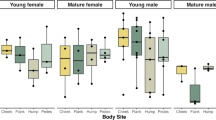Abstract
Secretions produced by sebaceous and apocrine glands of cervids may be important in identifying individuals, establishing dominance, and signaling sexual readiness. The secretions from these glands are transferred to the hair for both lubrication and scent communication via forehead rubbing. We collected hair samples from the forehead and back of 10 male white-tailed deer (Odocoileus virginianus) of various ages and analyzed them with gas chromatography–mass spectrometry to determine age-related differences. Fifty-seven compounds were identified, including alkanes, arenes, aldehydes, ketones, aliphatic alcohols, terpenes, terpene alcohols, and phenols. Although forehead apocrine glands of dominant deer become more active during the breeding season, we found that concentrations of eight compounds found on the forehead hair were higher in subordinate deer, while only one was higher in dominant deer. Subordinate deer may have higher concentrations of these compounds because they rub less frequently than dominant deer. Additionally, only five forehead hair volatiles differed in concentration from those taken from the back hair. This seems to indicate that an increase in forehead glandular activity may take place concurrently with an increase in general integumentary glandular activity. The variation in hair volatiles among individuals also may be indicative of an individual-specific odor that could aid in identification.
Similar content being viewed by others
REFERENCES
ALBONE, E. S. 1984. Mammalian Semiochemistry. John Wiley & Sons, New York, 360 pp.
ATKESON, T. D., and MARCHINTON, R. L. 1982. Forehead glands in white-tailed deer. J. Mammal. 63:613–617.
FORAND, K. J., and MARCHINTON, R. L. 1989. Patterns of social grooming in adult white-tailed deer. Am. Midl. Nat. 122:357–364.
FUDGE, J. R., MILLER, K. V., MARCHINTON, R. L., COLLINS, D. C., and TICE, T. R. 1992. Effects of exogenous testosterone on the scent-marking and agonistic behaviors of white-tailed deer, pp. 477–483, in R. L. Doty and D. Müller-Schwarze (eds.). Chemical Signals in Vertebrates 6. Plenum Press, New York.
GASSETT, J. W. 1995. Chemical analysis of the volatile compounds from the forehead and interdigital glands of male white-tailed deer. Master's thesis. University of Georgia, Athens.
JOHNSON, E., and LEASK, J. T. S. 1977. Metabolism of testosterone by forehead skin of the roebuck (Capreolus capreolus). J. Endocrinol. 75:363–372.
KILE, T. L., and MARCHINTON, R. L. 1977. White-tailed deer rubs and scrapes: Spatial, temporal, and physical characteristics and social role. Am. Midl. Nat. 97:257–266.
LEHNER, P. N. 1979. Handbook of Ethological Methods. Garland STPM Press, New York.
MARCHINTON, R. L., and HIRTH, D. H., 1984. Behavior, pp. 129–168, in L. K. Halls (ed.). White-tailed deer Ecology and Management. Stackpole Books, Harrisburg, Pennsylvania.
MCCONNELL, M. L., RHODES, G., WATSON, U., and NOVOTNY, M. 1979. Application of pattern recognition and feature extraction techniques to volatile constituent metabolic profiles obtained by capillary gas chromatography. J. Chromatogr. 162:495–506.
MECH, D. L., DEL GIUDICE, G. D., KARNS, P. D., and SEAL, U. S. 1985. Yohimbine hydrochloride as an antagonist to xylazine hydrochloride-ketamine hydrochloride immobilization of white-tailed deer. J. Wildl. Dis. 21:405–410.
MILLER, K. V., KAMMERMEYER, K. E., MARCHINTON, R. L., and MOSER, E. B. 1987. Population and habitat influences on antler rubbing by white-tailed deer. J. Wildl. Manage. 51:62–66.
MOORE, W. G., and MARCHINTON, R. L. 1974. Marking behavior and its social significance in white-tailed deer, pp. 447–456, in V. Geist and F. R. Walther (eds.). The Behaviour of Ungulates and its Relation to Management. Ser. Pub. 24. International Union for the Conservation of Nature, Morges, Switzerland.
MÜLLER-SCHWARZE, D. 1971. Pheromones in black-tailed deer (Odocoileus hemionus columbianus). Anim. Behav. 19:141–152.
MULLER-SCHWARZE, D. 1972. Social significance of forehead rubbing in black-tailed deer (Odocoileus hemionus columbianus). Anim. Behav. 20:788–797.
MÜLLER-SCHWARZE, D., VOLKMAN, N. J., and ZEMANEK, K. F. 1977. Osmetrichia: Specialized scent hairs in black-tailed deer. J. Ultrastruct. Res. 59:223–230.
NOVOTNY, M., LEE, M. L., and BARTLE, K. D. 1974. Some analytical aspects of the chromatographic headspace concentration method using a porous polymer. Chromatographia 7:333–338.
OZOGA, J. J., and VERME, L. J. 1985. Comparative breeding behavior and performance of yearling vs. prime-age white-tailed bucks. J. Wildl. Manage. 49:364–372.
SAWYER, T. G., MARCHINTON, R. L., and MILLER, K. V. 1989. Response of female white-tailed deer to scrapes and antler rubs. J. Mammal. 70:431–433.
VOLKMAN, N. J., ZEMANEK, K. F., and MÜLLER-SCHWARZE, D. 1978. Antorbital and forehead secretions of black-tailed deer (Odocoileus hemionus columbianus). Anim. Behav. 26:1098–1106.
Rights and permissions
About this article
Cite this article
Gassett, J.W., Wiesler, D.P., Baker, A.G. et al. Volatile Compounds from the Forehead Region of Male White-Tailed Deer (Odocoileus virginianus). J Chem Ecol 23, 569–578 (1997). https://doi.org/10.1023/B:JOEC.0000006397.63647.5b
Issue Date:
DOI: https://doi.org/10.1023/B:JOEC.0000006397.63647.5b




